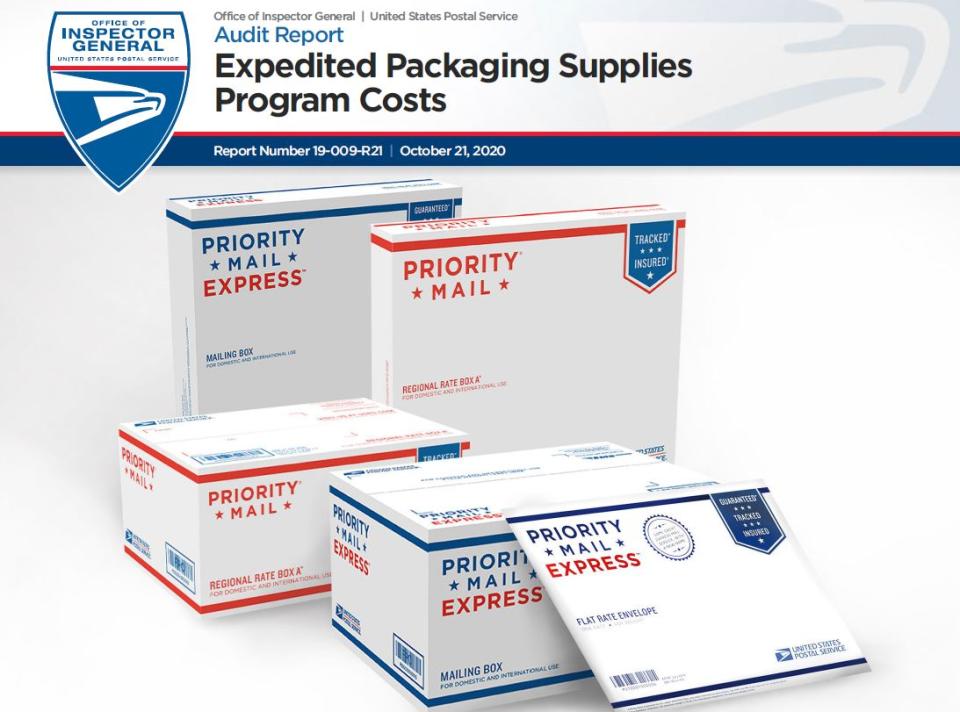Expedited Packaging Supplies Program Costs
Objective
The Postal Service provides free expedited packaging supplies (EPS) for use with its domestic and international Priority Mail and Priority Mail Express services. Packaging items include rigid containers and envelopes and a range of pressure sensitive labels and decals. There are three categories of packaging supplies: standard, specialized, and customized.
- Standard packaging is available to customers through its fulfillment centers and local post offices. There are over 50 standard items available for domestic and international Priority Mail and Priority Mail Express, including envelopes, boxes, tubes, mailing labels, tags, and stickers.
- Specialized packaging is available to qualifying customers when standard supplies will not meet their needs. For our review period, customers must have generated a minimum of $50,000 in annualized expedited revenue to be eligible for specialized packaging. There are 16 specialized boxes of various sizes and five envelopes available to qualifying customers when standard packaging does not meet their needs.
- Customized packaging is designed to fit specific needs of the customer and is available when standard or specialized packaging does not meet customer needs. For our review period, customers must have generated a minimum of $250,000 in annualized expedited revenue to be eligible for customized packaging. The packaging consists of boxes, envelopes, cohesive packaging, and address labels. It can also include cobranding the packaging with the customer’s logo.
The Postal Service incurred about [redacted] billion in EPS costs from fiscal year (FY) 2015 to FY 2019. In FY 2019, it attributed about [redacted] million of EPS costs to expedited products.
Our objective was to assess whether the Postal Service is effectively achieving EPS program objectives, controlling program costs, and accurately attributing costs to products. We began fieldwork before the President of the U.S. issued the national emergency declaration concerning the novel coronavirus disease (COVID-19) outbreak on March 13, 2020. The results of this audit do not reflect any management process changes related to the expedited packaging supplies program that may have occurred as a result of the pandemic.
Findings
The Postal Service did not always distribute specialized and customized packaging to customers in line with EPS program revenue objectives and policy requirements. We found that from FY 2015 to FY 2019, 71 of 253 specialized packaging customers (about 28 percent) did not meet their annual revenue commitments within a 12-month period. In addition, 17 of 165 customized packaging customers (about 10 percent) did not meet the annual revenue commitments during FY 2015 to FY 2019. This occurred because management did not always effectively monitor customer revenue generation or consistently limit supplies for ineligible customers.
We estimated that from FY 2015 to FY 2019, the Postal Service distributed about $1.1 million in specialized packaging to customers who had not met expedited revenue commitments. In total, these customers missed revenue commitments by about $4.3 million. While the Postal Service has reduced the costs of providing this packaging to ineligible customers by about 57 percent from FY 2015 to FY 2019, we believe management could further curtail these actions to mitigate unnecessary costs going forward. We were unable to determine the value of customized packaging provided to customers who did not meet their revenue commitments due to EPS data limitations.
Opportunities also exist for the Postal Service to more effectively control EPS program costs through enhanced monitoring of standard packaging usage. We found that the Postal Service could not verify whether about 1 billion free standard boxes and envelopes (about 44 percent) procured from FY 2015 through FY 2019 re-entered the mailstream. The Postal Service could not fully account for standard items because it:
- Did not track usage data for all automated and manually processed mailpieces in expedited packaging that re-entered the mailstream.
- Did not track all expedited packaging mailpieces shipped at non-expedited postage rates, which prevented identifying and recovering costs for some improper EPS usage.
- Had limited controls over its online and post office EPS ordering and distribution (for example, customers can submit multiple orders to circumvent the single-order dollar threshold) and no EPS reporting and distribution controls at any post offices.
- Did not sufficiently monitor EPS data from its standard packaging supplier.
Without the ability to fully account for EPS in the mailstream or to identify and remediate postage shortages due to improper use, the Postal Service has a limited ability to assess the EPS program’s effectiveness in increasing expedited revenue and volume and more effectively manage and control EPS program costs.
Further, we found that the Postal Service did not accurately attribute EPS costs between domestic and international expedited products. Specifically, it did not distribute EPS costs for about 27 percent of expedited mail volume between domestic and international products for FY 2019.
The Postal Service omitted relevant volumes when distributing costs because it did not update costing calculations to account for changes to several mail categories. As a result, the Postal Service overestimated costs for international expedited products and underestimated costs for domestic expedited products by about $92,000 each for FY 2019.
Recommendations
We recommended management:
- Continue to enhance monitoring of customer revenue generation to prevent distribution of specialized and customized packaging to ineligible customers.
- Evaluate and implement, as appropriate, available options to gather more complete expedited packaging usage data.
- Evaluate and implement, as appropriate, available technology to scan all expedited mailpieces to identify and recover postage due from improper usage of expedited packaging.
- Enhance online EPS ordering controls to prevent customers from circumventing order thresholds and to further discourage waste.
- Develop a mechanism to provide greater visibility over EPS at all post offices and periodically distribute and review data reports from the standard packaging supplier’s information tool to evaluate the cost effectiveness of the EPS program.
- Update costing calculations to reflect all expedited product categories, and periodically review expedited product categories to ensure calculations are up to date.

